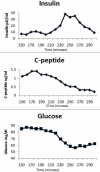Oral insulin: the rationale for this approach and current developments
- PMID: 20144296
- PMCID: PMC2769870
- DOI: 10.1177/193229680900300322
Oral insulin: the rationale for this approach and current developments
Abstract
Insulin remains the most effective and durable hypoglycemic agent for the treatment of diabetes. The addition of an effective oral insulin dosage form to the antidiabetes armamentarium may have significant benefits in terms of fostering compliance and adherence among patients, as well as physiologic advantages due to the fact that such a dosage form replicates the natural route of insulin secretion and absorption through the portal vein and targets the liver directly. Several companies have developed technological platforms that protect polypeptides and proteins from enzymatic hydrolysis, enable their transport across the epithelial lining, and promote their absorption from the gastrointestinal tract. A review of the potential physiological rationale and advantages, as well as of current pertinent technologies used specifically with insulin, is herewith provided.
2009 Diabetes Technology Society.
Figures


Similar articles
-
The physiological rationale for oral insulin administration.Diabetes Technol Ther. 2004 Aug;6(4):510-7. doi: 10.1089/1520915041705929. Diabetes Technol Ther. 2004. PMID: 15321008 Review.
-
Nanoparticle strategies for the oral delivery of insulin.Expert Opin Drug Deliv. 2008 Jan;5(1):45-68. doi: 10.1517/17425247.5.1.45. Expert Opin Drug Deliv. 2008. PMID: 18095928 Review.
-
Oral delivery of insulin for treatment of diabetes: status quo, challenges and opportunities.J Pharm Pharmacol. 2016 Sep;68(9):1093-108. doi: 10.1111/jphp.12607. Epub 2016 Jun 30. J Pharm Pharmacol. 2016. PMID: 27364922 Review.
-
Oral insulin delivery: how far are we?J Diabetes Sci Technol. 2013 Mar 1;7(2):520-31. doi: 10.1177/193229681300700228. J Diabetes Sci Technol. 2013. PMID: 23567010 Free PMC article. Review.
-
[Away with the needle. Noninvasive administration routes for insulin: improved quality of life for diabetics?].Pharm Unserer Zeit. 2001;30(2):136-41. doi: 10.1002/1615-1003(200103)30:2<136::AID-PAUZ136>3.0.CO;2-W. Pharm Unserer Zeit. 2001. PMID: 11279984 Review. German. No abstract available.
Cited by
-
Chemically Precise Glycoengineering Improves Human Insulin.ACS Chem Biol. 2018 Jan 19;13(1):73-81. doi: 10.1021/acschembio.7b00794. Epub 2017 Dec 1. ACS Chem Biol. 2018. PMID: 29090903 Free PMC article.
-
Insulin therapies: Current and future trends at dawn.World J Diabetes. 2013 Feb 15;4(1):1-7. doi: 10.4239/wjd.v4.i1.1. World J Diabetes. 2013. PMID: 23493823 Free PMC article.
-
Barriers and facilitators to insulin treatment: a phenomenological inquiry.J Pharm Policy Pract. 2022 Jul 19;15(1):45. doi: 10.1186/s40545-022-00441-z. J Pharm Policy Pract. 2022. PMID: 35854336 Free PMC article.
-
Glucose-reducing effect of the ORMD-0801 oral insulin preparation in patients with uncontrolled type 1 diabetes: a pilot study.PLoS One. 2013 Apr 9;8(4):e59524. doi: 10.1371/journal.pone.0059524. Print 2013. PLoS One. 2013. PMID: 23593142 Free PMC article. Clinical Trial.
-
Insulin Tregopil: An Ultra-Fast Oral Recombinant Human Insulin Analog: Preclinical and Clinical Development in Diabetes Mellitus.Drugs. 2023 Sep;83(13):1161-1178. doi: 10.1007/s40265-023-01925-1. Epub 2023 Aug 14. Drugs. 2023. PMID: 37578592 Review.
References
-
- Meier JJ, Holst JJ, Schmidt WE, Nauck MA. Reduction of hepatic insulin clearance after oral glucose ingestion is not mediated by glucagon-like peptide 1 or gastric inhibitory polypeptide in humans. Am J Physiol Endocrinol Metab. 2007;293(3):E849–E856. - PubMed
-
- Eaton RP, Allen RC, Schade DS. Hepatic removal of insulin in normal man: dose response to endogenous insulin secretion. J Clin Endocrinol Metab. 1983;56(6):1294–1300. - PubMed
-
- Meistas MT, Rendell M, Margolis S, Kowarski AA. Estimation of the secretion rate of insulin from the urinary excretion rate of C-peptide. Study in obese and diabetic subjects. Diabetes. 1982;31(5 Pt 1):449–453. - PubMed
-
- Satake S, Moore MC, Igawa K, Converse M, Farmer B, Neal DW, Cherrington AD. Direct and indirect effects of insulin on glucose uptake and storage by the liver. Diabetes. 2002;51(6):1663–1671. - PubMed
-
- Camacho RC, Pencek RR, Lacy DB, James FD, Wasserman DH. Suppression of endogenous glucose production by mild hyperinsulinemia during exercise is determined predominantly by portal venous insulin. Diabetes. 2004;53(2):285–293. - PubMed
Publication types
MeSH terms
Substances
LinkOut - more resources
Full Text Sources
Medical

